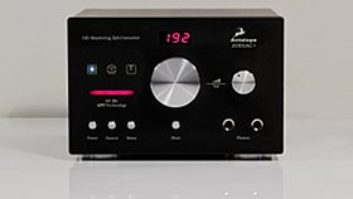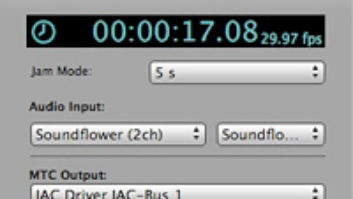Well-known for making the reliable Aardsync II master clock,Aardvark touts its DirectPro 24/96 as the “all-in-onepersonal studio system.” With four discrete mic preamps, 48Vphantom power, 24-bit 96kHz converters, a headphone amp, digitalI/O, six analog output channels and a virtual mixer, the DirectProcomes surprisingly close to a complete studio. Bring your owntransducers — headphones, speakers and microphones —and you’re almost there.
The actual recording and editing takes place in the software ofyour choice. The Aardvark package includes Cakewalk Pro Audio 9,but it should be understood that the DirectPro does not actuallyrecord. It is an extremely efficient input/output for a widevariety of available programs. The 10-channel virtual mixerfeatures EQ, compression (on input only) and reverb, all with zerolatency, so you can hear your adjustments in real time, withoutwaiting for the computer to calculate the changes. Typical latencyin similar devices is around half a second.
Out of the box, the system appears simple: two software disks, amanual, a PCI card, a breakout box and a sturdy shielded 25-pincable. The breakout box has four combo ¼-inch/XLR inputs, aphantom power switch with LED and a headphone jack on the frontpanel; the rear panel has four ¼-inch outputs, two RCAoutputs, and MIDI in and out. S/PDIF in and out can be found on thecard at the back of the computer. All ¼-inch jacks allow bothbalanced and unbalanced connections at +4 dBu and -10 dBu,respectively.
Optional accessories include rack adapters for one or twobreakout boxes (each occupy two rackspaces) and AES/EBU-to-S/PDIFadapters (manufactured by Aardvark to change voltage andimpedance).
The manual is brief but effective, with separate instructionsfor installation on both Windows 95 and Windows 98 platforms. Afterconsulting the recommendations for the placement of the PCI cardinto my computer, onscreen messages prompted me through the rest ofthe install. Thereafter, I only consulted the 35-page pamphlet forquick-start guides that explain integration of the DirectPro withSamplitude, Cubase VST, Cakewalk Pro Audio, Sound Forge andWavelab.
THE INSTALL
For DirectPro, Aardvark recommends a Pentium PC or compatible,running at 200 MHz or higher, with Windows 95 or Windows 98, aminimum of 64MB RAM and one available PCI slot. For this review, Iused a modestly equipped 300MHz Pentium II 300A PC with CD-ROM/DVDdrive, 128MB RAM and 4 GB of available disk space.
Hardware installation was simple. However, the DirectProsoftware didn’t load properly the first time I tried, but techsupport at Aardvark is excellent (there was always more than oneable-minded technician available when I called during East Coastbusiness hours), and they e-mailed me the file I needed for asmooth install.
ONSCREEN
The virtual console — or “Control Panel”screen — is laid out well, with four channel strips on theleft for the four inputs. Each of these includes gain, compression,EQ, reverb send, pan and a “fader,” while the playback(or output of the recording program) appears on the right as threepermanently linked stereo pairs with reverb sends. Each channel hasa Mute and a Solo switch, but the playback pairs will not mute orsolo one side of the stereo pair — this has to be done withinthe recording/editing program you’ve selected.
All 10 channels are summed to the stereo-linked master fader(“Monitor Out”). There are 12 replicas of LED-stylemeters, one next to each fader. Each meter uses over 40 segments ingreen, yellow and red, and peak hold is an option. There is also alarge replica of a 2-channel VU meter, redundant with the MonitorOut “LEDs.” The VU meter “needles” areunderstandably slow to react, as Aardvark has justifiably assignedtheir movement a low priority in terms of DSP operations.
Below the VU section is the Master Reverb panel, with controlsfor Decay, Diffusion, Brightness and Room Size (“Room,”“Hall” or “Church”). A Preset button opensa window of reverb presets (initially blank until favorite settingsare stored here), and the master reverb return is either on or off(no level control) according to the Bypass button.
Under the reverb section, there are buttons for Source Select,Presets (snapshots of the entire console available for instantrecall), Advanced and Patch Bay. The Source Select buttondetermines whether the sampling rate is internally clocked at32/44.1/48/96 kHz or externally for incoming S/PDIF signals. (SCMSis thankfully deactivated.) The Advanced button opens a window thatmonitors the status of the I/O driver pairs (active or inactive),shows the serial number and registration key number, adjusts theASIO buffer and sample size and gives the option for the program toissue warnings on sample rate errors. New in the Advanced window(Version 2.2) is output level selection for playback channels 1through 4; all four can either output +4 dBu or -10 dBu — nomixed choices. Incidentally, output channels 5 and 6 are -10dBu RCAplugs.
The Patch Bay window allows most conceivable routings; forexample, playback channels 1 and 2 can be assigned to output jacks5 and 6. However, one cannot connect playback channels 1 through 6correspondingly to outputs 1 through 6 while still monitoring allsix through the DirectPro headphone jack. This limitation issurmountable with the use of external monitoring equipment, such asa small mixer. While “Analog 1, 2 Out” has its ownpatch point, “Analog 3, 4 Out” and “Analog 5, 6Out” share their patch points with “S/PDIF L/ROut” and “Headphone L, R Out,” respectively. Thiscan create limitations as with the previously cited example. ThePatch Bay also includes a test tone, which can route to all threeoutput points at once.
PRACTICE
Using the DirectPro as a mic preamp and a digital mixer, Icombined live tracks with a stereo DAT and recorded to the harddrive with a variety of multitrack editing programs. The S/PDIFinput shows up on input channels 3 and 4 and allows a large degreeof gain in the digital domain. A square at the top of the channelsilluminates when digital interfacing is correct, even when tape isnot rolling — a handy feature. Unfortunately, only onedigital signal may be input at once, even when multiple DirectProunits are ganged together.
The gain for analog inputs is well-thought out, with threeseparate gain stages, all optimized for their range: one for largeamounts of mic preamplification, one for nominal amounts and onefor line-level inputs. Although the line amp only allows up to 9 dBof gain, the mic pre’s provide up to 75 dB. Input gain is done inthe analog stage to maximize audio level before the A/D conversion.The discrete, eight transistor-per-channel preamps sound very good— the specs boast a frequency response of 1.6 to 200k Hz (at-3 dB). Acoustic guitar, banjo, snare and vocals were capturedextremely well, retaining their brightness without soundingbrittle. While playing along to the DAT, DirectPro followed theclock of the DAT machine, which was playing at 48 kHz.
Next, I tried recording the same instruments at 96 kHz.Reproduction quality was predictably better — increaseddefinition was accentuated by the quietness of the card. Thecombination of discrete mic pre’s with 24-bit resolution makes thissetup a real bargain.
One disadvantage of selecting a 96kHz sampling rate is that theEQ, compression and reverb are disabled, but I really didn’t usethem that often. Although the reverb is handy for monitoring whileoverdubbing, the EQ and compression are not very effective. Forexample, the low-frequency knob is fixed at 220 Hz — almostuseless as a bass roll-off. The high frequency is set at 8 kHz,where 12 kHz or higher might have been a better choice. The midfrequency is adjustable but with no bandwidth selection, and it isstepped at frequencies that are too far apart, especially below 1kHz and above 5 kHz. Additionally, the compressor cannot be usedsolely as a limiter, nor does it provide a gain-reduction meter.The lack of visual confirmation of its action was unnerving.
While not in 96kHz mode, the RecFX button on each input channelallows EQ and compression to be recorded along with real-timevolume changes. Otherwise, the input gain stage is sent directly tothe recording software, with the bulk of the console acting as amonitoring path. Reverb can also be recorded, but only afterselecting inputs 5 and 6 in the Patch Bay window.
Auxiliary sends on each channel would have been useful, but Imanaged to fashion an effects loop by assigning one of the playbackpairs to analog outputs on the breakout box. By panning individualinstruments hard left or hard right, they can be sent to externalprocessors and returned to one of the four input channels. Ofcourse, software plug-ins can also be utilized. In both cases, onemust make auxiliary output assignments within the chosen editingsoftware (such as the mixer in CoolEditPro).
The DirectPro Control Panel is best used as an input stage andmonitoring console — especially for overdubbing —rather than as a mixing device. Automation of Control Panelsettings through MIDI is not possible — the MIDI I/O is onlyfor conveying MIDI data to the host software. I had many digitaland analog tapes in need of editing, and their sound was nevercompromised through the Aardvark. I also tried a variety ofmicrophones — AKG 414s; Countryman Iso Omnis; Shure SM57s andother dynamic models — on various voices and instruments,always with great results.
On my wish list, I would have liked a knob on the breakout boxfor headphone volume (as opposed to adjusting the Monitor Outfader) — the knob is included on Aardvark’s Direct Pro LX6,which does not feature XLR inputs. The DirectPro’s EQ andcompression leave a bit to be desired, but the wide variety ofplug-ins available can take care of most situations.
Certainly, the unit’s zero latency performance is a major plus,although DirectPro’s real strength lies in the sound quality of thepreamps and conversion process. The gain stages sound very good,certainly better than the ubiquitous preamps we find in many budgetconsoles, and, in general, the audio is extremely quiet. Credit isdue to Aardvark for shielding the PCI card so well.
With the addition of 24-bit, 96kHz converters and the inclusionof Cakewalk Pro Audio 9, this package is hard to beat, especiallyat a U.S. list price of $699. It should also be noted that Aardvarkexpects to release Windows 2000 and Macintosh in the near future.Overall, DirectPro is an excellent interface for computer audiowork. I’ve decided to keep this one!
Aardvark, 202 E. Washington, Suite 306, Ann Arbor, MI 48104;734/665-8899; fax 734/665-0694; www.aardvark-pro.com.
David Ogilvy is a Northern California recording andbroadcast engineer and producer.



